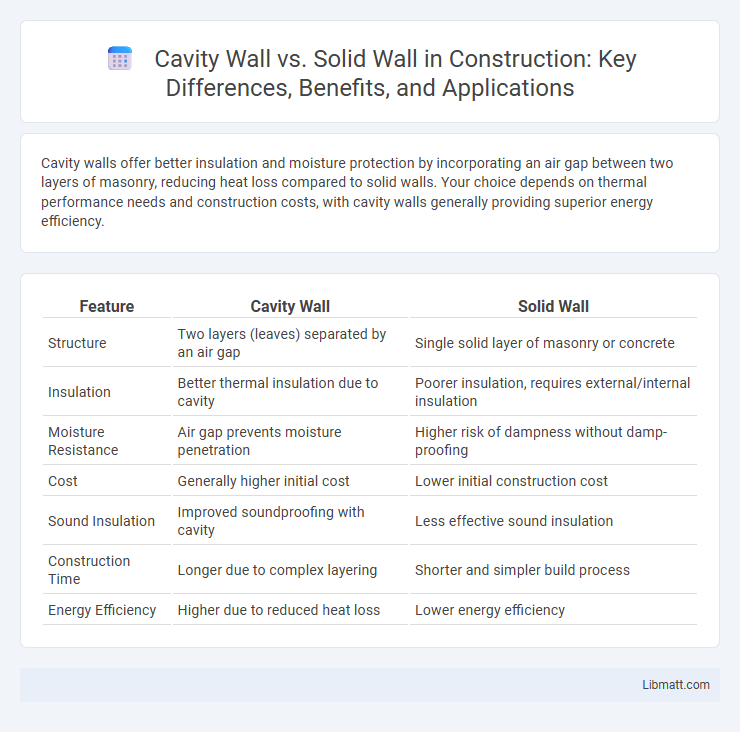Cavity walls offer better insulation and moisture protection by incorporating an air gap between two layers of masonry, reducing heat loss compared to solid walls. Your choice depends on thermal performance needs and construction costs, with cavity walls generally providing superior energy efficiency.
Table of Comparison
| Feature | Cavity Wall | Solid Wall |
|---|---|---|
| Structure | Two layers (leaves) separated by an air gap | Single solid layer of masonry or concrete |
| Insulation | Better thermal insulation due to cavity | Poorer insulation, requires external/internal insulation |
| Moisture Resistance | Air gap prevents moisture penetration | Higher risk of dampness without damp-proofing |
| Cost | Generally higher initial cost | Lower initial construction cost |
| Sound Insulation | Improved soundproofing with cavity | Less effective sound insulation |
| Construction Time | Longer due to complex layering | Shorter and simpler build process |
| Energy Efficiency | Higher due to reduced heat loss | Lower energy efficiency |
Introduction to Cavity Wall and Solid Wall
Cavity walls consist of two separate walls, typically made of brick or block, with a gap or cavity between them that improves insulation and reduces moisture penetration. Solid walls are constructed from a single layer of masonry material such as brick, stone, or concrete, often leading to poorer thermal performance compared to cavity walls. Understanding the structural differences is essential for optimizing thermal efficiency, moisture control, and building durability in construction projects.
What is a Cavity Wall?
A cavity wall consists of two separate walls, known as leaves or skins, with a gap or cavity between them that improves thermal insulation and prevents moisture penetration. This air gap can be filled with insulating materials, enhancing energy efficiency and reducing heat loss compared to a solid wall. Understanding what a cavity wall is can help you make informed decisions about building construction or home insulation upgrades.
What is a Solid Wall?
A solid wall is a type of building construction made from a single, continuous layer of material such as brick, concrete, or stone, offering structural support and thermal mass. Unlike cavity walls, solid walls lack an air gap between the inner and outer layers, which can result in lower insulation performance. Retrofitting solid walls with external or internal insulation can significantly improve energy efficiency and reduce heat loss.
Key Differences Between Cavity and Solid Walls
Cavity walls consist of two separate layers of masonry with a gap or cavity between them, offering enhanced insulation and moisture resistance, while solid walls are made from a single, solid layer of material like brick or concrete block. Cavity walls provide superior thermal performance by reducing heat transfer, resulting in better energy efficiency compared to solid walls, which tend to retain moisture and have lower insulation properties. Construction complexity and cost are typically higher for cavity walls due to the additional materials and labor required to create the cavity and install insulation.
Insulation Properties: Cavity Wall vs Solid Wall
Cavity walls provide superior insulation by incorporating an air gap between two layers of masonry, reducing heat transfer and preventing moisture penetration. Solid walls lack this air gap, resulting in higher thermal conductivity and greater heat loss, often necessitating additional insulation measures. Modern cavity wall designs can achieve U-values as low as 0.3 W/m2K, while uninsulated solid walls typically have U-values around 2.0 W/m2K, highlighting the significant energy efficiency benefits of cavity constructions.
Energy Efficiency Comparison
Cavity walls offer superior energy efficiency compared to solid walls due to their dual-layer construction that traps air as an insulating barrier, reducing heat loss significantly. Solid walls, being single-layered, have higher thermal conductivity, resulting in greater heat transfer and increased energy consumption for heating or cooling. Improving your home's energy efficiency is more achievable with cavity wall insulation, which can reduce heat loss by up to 50% compared to uninsulated solid walls.
Cost Implications and Materials
Cavity walls generally incur higher initial costs due to the need for two layers of masonry with an air gap filled by insulation materials like foam or mineral wool, enhancing thermal efficiency and reducing energy bills over time. Solid walls typically require less material but often need additional insulation retrofitted internally or externally, which can increase long-term expenses and disruption. Material costs for cavity walls include bricks, mortar, insulation, and labor, whereas solid walls primarily rely on dense bricks or concrete blocks, potentially leading to higher heating costs without proper insulation.
Moisture and Damp Protection
Cavity walls provide superior moisture and damp protection due to the air gap between the inner and outer layers, which acts as a barrier preventing water penetration into the interior. Solid walls lack this gap, making them more susceptible to dampness and requiring additional damp-proofing treatments to avoid moisture ingress. Proper installation of cavity wall insulation further enhances the wall's ability to resist moisture, reducing the risk of mold and structural damage.
Which Wall Type is Best for Your Home?
Cavity walls provide superior insulation and moisture resistance, making them ideal for energy-efficient homes and damp climates. Solid walls, often found in older constructions, have lower insulation values but offer robust structural strength and simpler installation. Choosing the best wall type depends on your home's age, local climate, and insulation requirements to balance energy savings and durability.
Conclusion: Choosing Between Cavity Wall and Solid Wall
Choosing between cavity wall and solid wall depends on factors such as insulation needs, budget, and climate. Cavity walls offer superior thermal insulation and moisture resistance, making them ideal for energy efficiency and damp prevention. Your decision should align with your property's structural requirements and long-term maintenance considerations.
Cavity wall vs Solid wall Infographic

 libmatt.com
libmatt.com